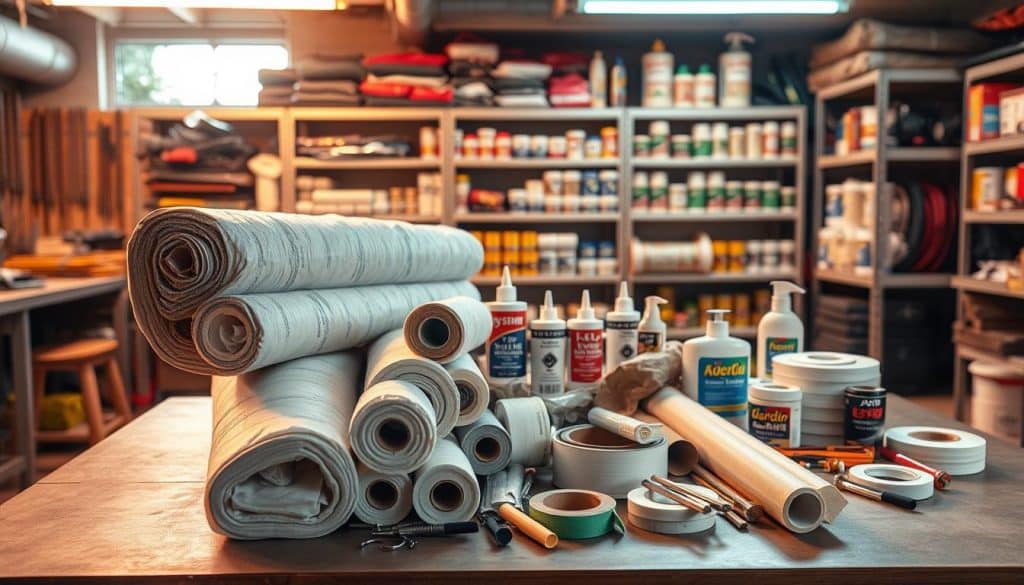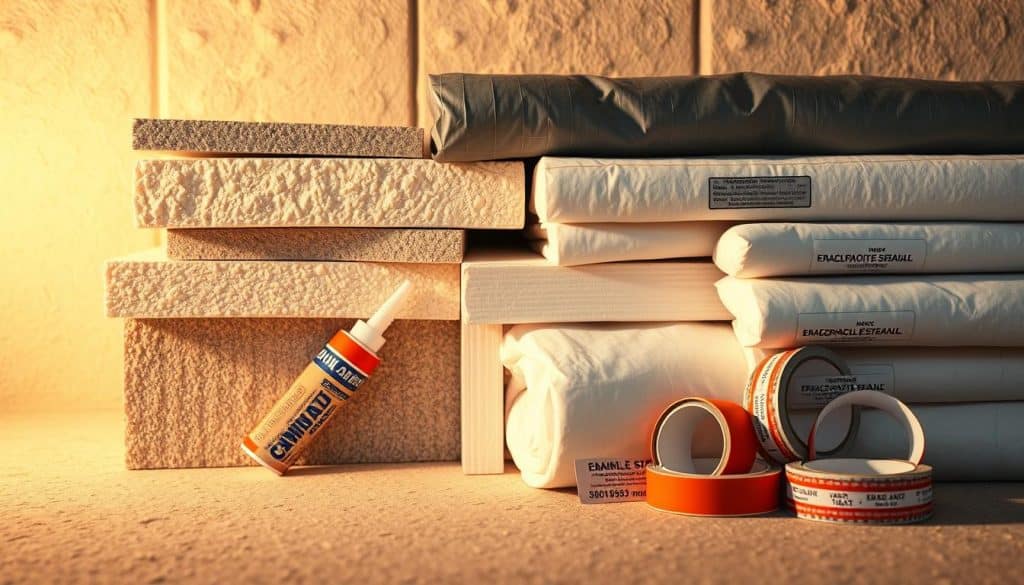Table of Contents
Ever thought about What Materials Are Used in Crawl Space Encapsulation? Let’s explore the materials used in crawl space encapsulation. You’ll see how they help your home fight off moisture, pests, and structural problems.
This article will show you the key materials for crawl space encapsulation. You’ll learn how they control moisture and improve energy efficiency. Plus, they help make the air inside your home cleaner.



Key Takeaways
- Crawl space encapsulation is critical for protecting homes from moisture and pest issues.
- Key materials include vapor barriers and insulation that enhance energy efficiency.
- Proper thickness and installation of vapor barriers are key for controlling moisture.
- Encapsulated spaces can lead to better indoor air quality and lower energy bills.
- Using high-quality materials is essential to avoid frequent repairs and ensure durability.
Understanding Crawl Space Encapsulation
Crawl space encapsulation is a key part of home improvement. It seals your crawl space with materials like vapor barriers and insulation. This stops moisture and keeps pests out. It’s vital for keeping your home healthy.Definition of Crawl Space Encapsulation
Crawl space encapsulation seals your home’s foundation and structure. It uses heavy-duty polyethylene barriers, from 6-mil to 20-mil thick. This method controls moisture and improves air quality.Importance of Crawl Space Encapsulation
Crawl space encapsulation is very important. It prevents mold and pests, protecting your home. Without it, up to 50% of your home’s air comes from the crawl space. Professional encapsulation can also lower your energy bills. It makes your home more energy-efficient. Plus, it can increase your home’s value, making it a smart investment.Key Materials Used in Crawl Space Encapsulation
Crawl space encapsulation uses key materials to control moisture. Plastic vapor barriers and insulation are the main ones. They work together to protect against moisture and boost energy efficiency.
Plastic Vapor Barriers
The plastic vapor barrier is the core of crawl space encapsulation. It’s made of heavy-duty polyethylene sheeting. This barrier stops water vapor from entering the crawl space. It’s important to calculate the total square footage for coverage. Add 10% to 20% for overlaps and mistakes. For beginners, a 20% overage is best to ensure full coverage.Insulation
Insulation is key for keeping a consistent temperature and saving energy. Foam board or fiberglass are common choices. A well-insulated crawl space can cut HVAC costs by 10% to 30%. Insulation and vapor barriers together create a dry, comfortable space. This reduces mold risk and moisture problems.Additional Components for Effective Encapsulation
Effective crawl space encapsulation is more than just vapor barriers and insulation. It also needs good crawl space drainage systems and dehumidifiers. These help manage moisture, making the space under your home dry and healthy. They are key to avoiding moisture problems and keeping encapsulation efforts working well.Drainage Systems
Crawl space drainage systems are key to keeping water away from your foundation. French drains, for instance, collect and move water, stopping it from gathering in the crawl space. A dry space lowers the chance of mold and mildew, which can harm your health. Good drainage systems are vital for managing moisture and making encapsulation successful.Dehumidifiers
Dehumidifiers boost encapsulation by controlling humidity. They keep moisture levels below 60%, stopping mold and improving air quality. Homes with encapsulated crawl spaces use less energy, thanks to better moisture control. Using dehumidifiers regularly helps keep your crawl space safe and breathable.Benefits of Crawl Space Encapsulation Materials
Crawl space encapsulation brings many benefits, like better moisture control and mold prevention. Using top-notch materials can greatly improve your home. Here are the main advantages of these practices.Moisture Control
Moisture control is key in crawl space encapsulation. A good vapor barrier and sealed gaps can cut down humidity. This helps avoid water damage, bad smells, and structural problems. Lower moisture also means a healthier home. This is great for people with allergies or breathing issues. It helps keep your home safe and healthy for everyone.Mold Prevention
Mold prevention is another big plus of good encapsulation materials. Mold loves damp, dark places, making crawl spaces perfect for it. But, encapsulation keeps moisture low, reducing mold spores. This is good for people with asthma or allergies. It also makes the air inside your home cleaner. This makes your home more comfortable and safe.
Installation Process of Encapsulation Materials
Starting a vapor barrier installation needs a careful plan. It’s about getting ready for crawl space encapsulation. Homeowners can try DIY encapsulation to save money and make their crawl spaces healthier.Preparing the Crawl Space
The first step is to get the crawl space ready. This means removing debris and fixing any moisture problems. A clean, dry surface is key for a successful project. A vapor barrier is usually 10 to 20 mils thick. This thickness offers good protection against moisture. Make sure to overlap seams by at least 12 inches for better protection. Also, insulation should go all the way down to the vapor barrier on the floor to seal everything off.Installing the Vapor Barrier
After getting the crawl space ready, it’s time to install the vapor barrier. Start by laying it down on the ground and up the walls. Sealing seams with special tape is important for a tight seal. A good vapor barrier can cut down moisture problems by up to 80%. Adding a crawl space dehumidifier helps keep humidity levels right. Regular upkeep of this unit can make it 30% more efficient. This leads to a healthier crawl space and lower energy costs.Choosing the Right Materials for Your Home
Choosing the right materials for your home’s crawl space is important. You need to think about the size of your crawl space, the local climate, and any moisture issues. Making the right choice is key for lasting results.Factors to Consider
When picking materials, several things matter. For instance, vapor barriers come in different thicknesses, from 10 to 20 mils. Homes in humid areas often face more moisture, needing stronger materials. Good insulation can save a lot on energy bills, up to 10-20%. A well-installed vapor barrier can also cut mold and mildew risk by up to 80%. This shows how important it is to pick the right stuff.Professional Consultation
Getting advice from experts is very helpful. They can look at your crawl space and suggest the best materials for it. They know about local building codes and what’s needed for insulation and fire safety. Working with pros means your solution will work well and meet all the rules. This makes your materials more effective.Common Mistakes in Material Selection
When you start crawl space encapsulation, many mistakes can happen. One big issue is picking the wrong materials. These materials might not handle your crawl space’s unique problems. Knowing your home’s specific needs is key to avoid problems like moisture and mold.Using Inadequate Materials
Choosing the wrong materials can cause big problems later. For example, a low-quality vapor barrier can let moisture through. Also, insulation without the right vapor protection can lead to condensation and damage. Always choose high-quality materials made for crawl spaces to last longer.Ignoring Local Regulations
Another big mistake is not following local building codes. Each area has its own rules for crawl space encapsulation. Not following these can lead to fines and extra work. Make sure to check the local codes to avoid problems and get the best results.Array of Solutions Services
Array of Solutions is all about keeping your home safe and healthy. They offer top-notch mold testing and inspection services in Greenville, SC. They respond quickly, doing detailed checks within 24 hours of your call. They use the latest technology to make sure every test is thorough. This helps keep your living space safe and sound. Array of Solutions knows how important it is to act fast on mold issues. They offer personalized service for every project. This means they follow local rules and meet your specific needs. With their help, you can easily add mold testing and inspection to your home care routine. They make it easy to keep your home in top shape.Areas We Serve in South Carolina
Array of Solutions is proud to serve many communities in South Carolina. We know each area has its own environmental needs. From Greenville to Spartanburg, we tackle water damage and mold with care. Our local knowledge lets us create solutions that fit each home’s needs.Greenville
In Greenville, we offer top-notch crawl space services. Our methods stop mold and improve air quality. We aim to save you money by making your home more energy-efficient.Spartanburg, Greer, and More
We also serve Spartanburg, Greer, Goose Creek, and Mt. Pleasant. Our systems make homes more comfortable and last a long time. With our help, your home will be dry and pest-free, making it a healthier place to live.Contact Array of Solutions for Expert Assistance
Thinking about crawl space encapsulation? Getting expert help is key to solving moisture issues. Array of Solutions offers personalized support for your crawl space needs. Their team has the skills and experience to protect your home from water damage.Phone and Email Information
Ready to get a quote or learn about crawl space options? Call Array of Solutions at (864) 710-6413. Or email them at scmoldremoval@gmail.com. They aim to keep your crawl space dry, energy-efficient, and free from mold and allergens. Don’t wait to tackle moisture issues. Working with Array of Solutions is a smart move. It helps protect your home and improves air quality. Contact them today to see how they can improve your crawl space.
FAQ
What is crawl space encapsulation?
Crawl space encapsulation seals the crawl space with materials like vapor barriers and insulation. This prevents moisture, pests, and boosts energy efficiency.
What materials are commonly used in crawl space encapsulation?
Common materials include heavy-duty vapor barriers and insulation like foam board or fiberglass. These help regulate temperature and improve energy efficiency.
How does a vapor barrier work?
A vapor barrier stops moisture from entering the crawl space. It keeps the area dry, which is key for good air quality and structure.
Why is insulation important in crawl space encapsulation?
Insulation keeps the crawl space temperature stable. It also prevents heat loss, making your home more comfortable and saving on energy bills.
Are drainage systems necessary for crawl space encapsulation?
Yes, drainage systems like French drains are vital. They direct excess water away from the foundation, reducing moisture risk.
How does a dehumidifier help in encapsulated crawl spaces?
A dehumidifier keeps humidity levels right in the crawl space. It stops mold growth and gets rid of musty smells, making your home healthier.
What factors should I consider when choosing encapsulation materials?
Think about the crawl space size, local climate, and moisture issues. Also, get advice from experts for the best materials for your space.
What common mistakes should I avoid in crawl space encapsulation?
Don’t pick materials that can’t handle the environment. Also, make sure your project follows local building rules to avoid problems later.
What services does Array of Solutions offer for crawl space encapsulation?
Array of Solutions offers mold testing, inspections, and custom advice. They ensure encapsulation projects meet local rules and homeowner needs.
What areas does Array of Solutions serve in South Carolina?
Array of Solutions serves many areas in South Carolina. This includes Greenville, Spartanburg, and Greer, providing top mold and moisture solutions.

